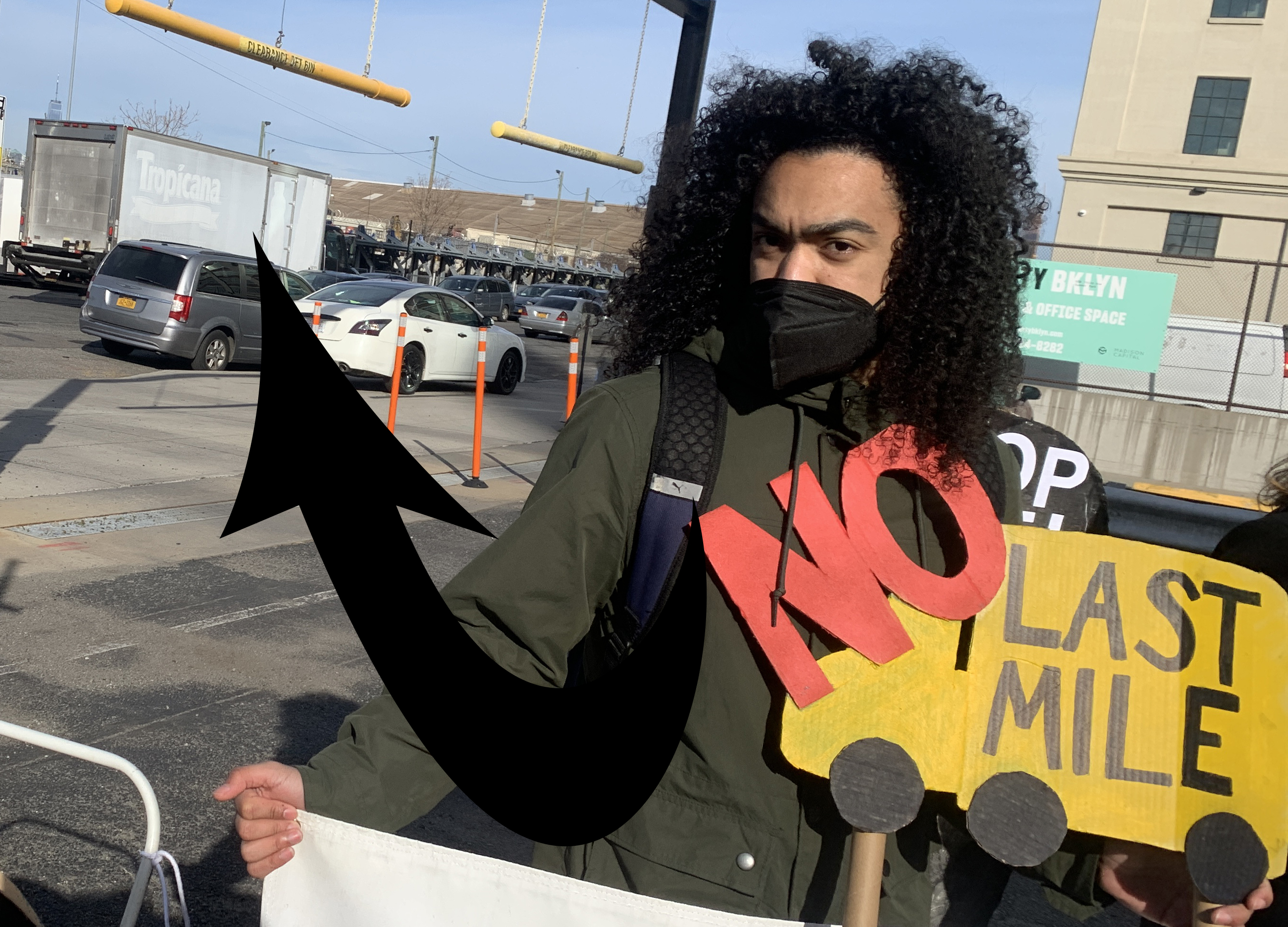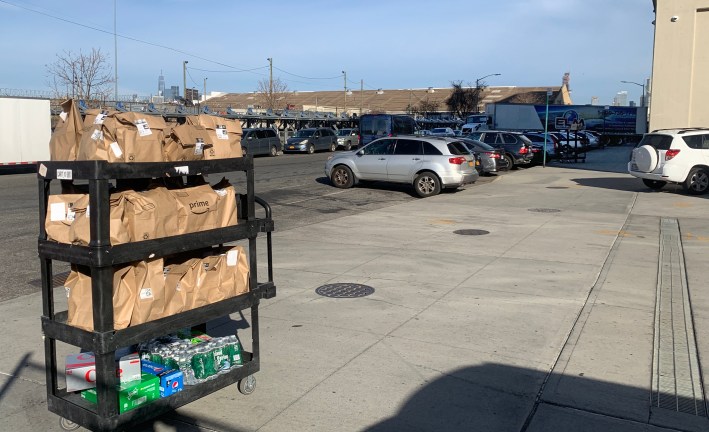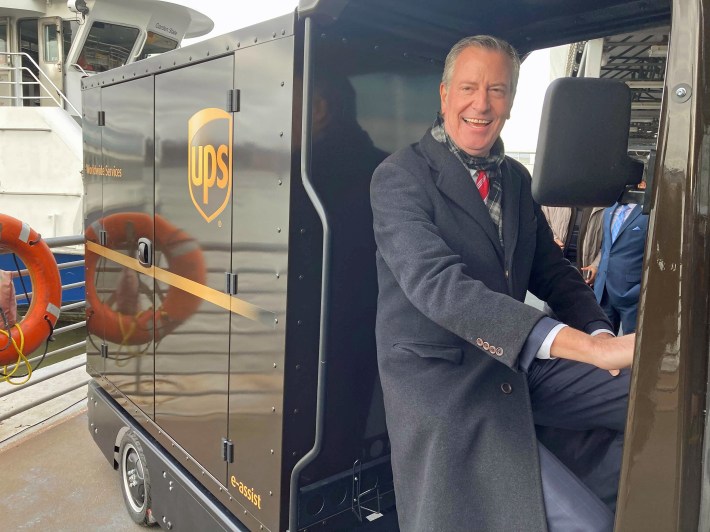Advocates: Change Zoning to Regulate ‘Last-Mile’ Trucking Facilities Flocking to Low-Income Communities
5:42 PM EST on December 15, 2021

All signs point to … the problem. Photo: Gersh Kuntzman

One man's last mile is another man's last gasp.
Environmental justice groups launched a new effort to rein in the proliferation of "last-mile" trucking facilities that are flocking to low-income communities with virtually no regulation, calling on Wednesday for the city's zoning code itself to require companies such as Amazon to make their distribution centers greener and safer.
Currently, such facilities — where trucks drop off goods for sorting and loading onto other trucks or cars for distribution to other neighborhoods — don't undergo environmental review because they are in manufacturing zones. And those zones are typically in low-income neighborhoods or communities of color with low land prices. As Streetsblog reported earlier this year, and The City reiterated this week, Sunset Park and Red Hook are particularly getting dumped on.
"They're all sited as-of-right with no review, based on 1961 zoning, which had a very different idea of what a 'warehouse' is," Eddie Bautista, executive director of the New York City Environmental Justice Alliance, said at the rally next to an Amazon distribution center in Sunset Park — one of more than a half-dozen that are in operation or being built in that neighborhood and neighboring Red Hook. Similar facilities for Amazon, UPS and FedEx are in poor neighborhoods all over the city. "It's the Wild West."
Of course, no deep environmental review is needed to assess the already-documented conditions in communities bearing the brunt of truck traffic: pollution is more severe, asthma rates are higher, pedestrian deaths are an epidemic. So beyond merely studying the problem, advocates are calling for the City Planning Commission to pass a "zoning resolution text amendment" that would require all new distribution centers to mitigate some of the damage they do.

For instance, a zoning amendment could block facilities from clustering or require companies to convert all trucks to electric vehicles or mandate solar power panels on the roof. Or the special permit could require companies to mitigate the damage they cause.
"There could be certain pedestrian safety measures required, there could be requirements that it's not going to significantly increase air pollution," said Rachel Spector, senior attorney at Earthjustice [sic], which is also in the new Last Mile Coalition, along with The Point, a Hunts Point community center and business incubator; UPROSE; and El Puente, a South Williamsburg group. "There are a number of conditions that can be part of the special permit process, not just to disclose an environmental impact, but actually mitigate the negative impacts."
City officials said they are not ignoring the plight of communities of color, where these trucking facilities profligate.
"We're quite aware of the situation in Red Hook and Sunset Park," DOT Commissioner Hank Gutman told Streetsblog on Wednesday. "I've taken tours with my team. We've met with the advocates. We've met with the local elected officials. And I think we share a common objective here, which is to keep oversized polluting trucks from destroying the quality of life in neighborhoods all around the city."
But, he added, changing existing trucking practices — and getting companies to shift to smaller, greener vehicles for the last mile — "present a challenge."
"Some of them are developments as a matter of right, so there's not a way to prevent them," he added. "But we certainly have the ability — and intend to use it at the DOT — to minimize the traffic impact and to make sure that they are good neighbors."
Gutman has spoken frequently about the challenge of dealing with the roughly 1.8 million packages that are delivered daily in New York City — a use of the roadways that simply did not exist 20 years ago and is contributing to the increase in road deaths this year, which is the bloodiest year of Mayor de Blasio's two terms. Last year, e-commerce accounted for 14 percent of all retails sales, up from 4 percent in 2007.
Assembly Member Bobby Carroll wants to put a $3 surcharge on every e-commerce order, in hopes of discouraging online purchases and to encourage people to shop locally, but the mayor opposes that measure.
Coincidentally, the environmental justice rally came about 90 minutes before city officials held their own press conference to promote the city's effort to increase the use of New York's waterways for getting freight around town. Mayor de Blasio announced what he called a “bold” plan [PDF] to shift many deliveries to more sustainable modes like by sea, train, and cargo bike, as opposed to the currently more than 120,000 gas-guzzling trucks that enter or leave the five boroughs every day.
The mayor, flanked by bigwigs from UPS, and his DOT and Economic Development Corporation, set out five goals that are now in the hands of the next mayor, given that de Blasio's term ends on Dec. 31:
- Make last-mile deliveries more efficient by promoting off-hour deliveries and expanding neighborhood loading zones, which exist in some neighborhoods, but are deeply opposed in areas with lots of car ownership. The city claims it will expand neighborhood loading zones to a total of 1,500 ... by 2040. There are a few dozen currently.
- Green the last mile by encouraging the transition to zero-emission truck fleets, and other sustainable modes like cargo bikes
- Enforce the last mile by seeking federal dollars to implement technology that would catch overweight trucks.
- Use the so-called "blue highway" by modernizing marine terminals like the Red Hook Container Terminal and expanding waterfront access so that more companies would ship freight by water instead of by truck, which currently carry 90 percent of freight into the city. The mayor pledged $38 million, which includes $18 million for a new pilot program "to spur private investments in marine vessels.”
- Use more rail, such as some extent capacity in Hunts Point. "Rail access is especially important for industrial businesses that must transport construction materials, bulk goods and heavy food products such as rice or tomato sauce," the document stated. "To induce more opportunities for sustainable, resilient, and competitive transport options, New York City will support the expansion of its 90 miles of freight rail lines and facilities where shipments are moved from railcars to 'last-mile' trucks."

Wednesday's presser follows almost identical promises in 2018 in the FreightNYC report and in a “Delivering New York" plan earlier this year — both of which were short on concrete details about how to actually improve the streetscape. And any plan still hinges on federal dollars.
Neither the mayor or any city reps took questions at the presser, but Gutman discussed greater use of the "blue highway" earlier in the day at the mayor's twice-weekly virtual presser.
"The great advantage of the blue highway is the goods arrive not by big truck, but by boat," Gutman said. "And then you unload them at those distribution centers, into cargo bikes, etcetera. So, I think there's a way here to find the true path. And we're determined to work as hard as we can to make that happen."
Bautista called that a good "first step," but one that does not address his group's main concern — the last-mile trucks and danger.
"The mayor is not talking about the clustering of these facilities," Bautista said. "But by requiring a special permit, we can require electric trucks or cargo bikes. And other safety measures."
The City Planning Commission did not get back to us before initial publication of this story. After, however, the agency offered this very cold water statement:
Zoning regulates use, bulk, and parking, but does not regulate the type or size of vehicles that travel to or from any use. Distribution and delivery are functions that support residents and businesses in a wide range of ways, and require suitable locations within the city. Warehouses and distribution facilities are allowed as-of-right in manufacturing districts, which are areas intended to accommodate uses that are best not to intermingle with residential communities.
Gersh Kuntzman is editor in chief of Streetsblog NYC and Streetsblog USA. He also writes the Cycle of Rage column, which is archived here.
Stay in touch
Sign up for our free newsletter
More from Streetsblog New York City
Adams Backs Lower Speed Limits, Calls Crashes ‘Accidents’
The mayor wants New York City drivers to "slow down," but it's not clear yet how many streets will get lower speed limits.
Wednesday’s Headlines: Trump Posts About Congestion Pricing Edition
Donald Trump comments on congestion pricing — no surprise, he's against it. Plus more news.
DOT Aims to Build First Ave. Tunnel Bike Lane Before September’s UN General Assembly
DOT hopes to have the concrete-protect tunnel bike lane installed this summer, but its exact plans are still in development.
Waste Reforms Could Require Data on Crashes, Dangerous Driving
The proposal affects at least one trucking company with a deadly driving record.
When it Comes to Federal Infrastructure Grants, Size Does Matter
Cities and municipalities with larger budgets and staff are more likely to win competitive federal infrastructure grants, the Urban Institute has found.




